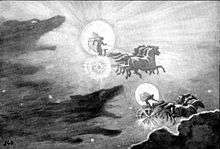Glæsisvellir
Glæsisvellir (meaning: glittering plains) was a location in Jotunheim in Norse mythology. It is mentioned in sources, such as Bósa saga ok Herrauds and Hervarar saga.[1]
Legend
In Glæsisvellir could be found a location called Ódáinsakr, or Údáinsakr (lit. "Deathless Acre", meaning the "Undying Lands"). Everyone who went there became healthy and young, and so no one ever died there. The Eireks saga víðförla is about a man who searched for and found Údáinsakr.
In the Hervarar saga, it is the kingdom of Gudmund and his son Höfund. Gudmund was a friendly giant who was popular in later sagas.
In Gesta Danorum, Saxo Grammaticus makes a reference to Odainsaker as the place where the Scanian governor Fialler retired after having been attacked by the Danish king Wiglek:
|
Fiallerum Scaniae praefectum exsilio adegit, quem ad locum, cui Undensakre nomen est, nostris ignotum populis concessisse est fama.[2] |
Fialler, the governor of Skaane, he drove into exile; and the tale is that Fialler retired to a spot called Undensakre, which is unknown to our peoples.[3] |
The Glæsisvellir and the Ódáinsakr have close counterparts in earlier motifs of Irish storytelling. Given the extremely close correspondence between the motif complex of the Glæsisvellir and the Ódáinsakr and Irish motifs, and given that the Irish sources pre-date the Norse sources (starting already in the late seventh century), it can be assumed that the Glæsisvellir and the Ódáinsakr are based on a borrowing of Irish motifs by Norse settlers of the Viking Age. While moving to Iceland, many of these settlers spent long periods of time in Britain and Ireland, which in some cases led to a reception of Irish motifs by the Norse.[4][5]
See also
- Elysian Fields
- Shangri-la
- Blessed Isle
- Tír na nÓg
- Glasir
References
- Rydberg, Viktor (1907). Teutonic Mythology, Vol. 1 of 3: Gods and Goddesses of the Northland. Library of Alexandria. ISBN 9781465507716.
- "Saxo Grammaticus: Gesta Danorum". Det Kongelige Bibliotek. Archived from the original on 2010-05-04. Retrieved 2017-09-26.
- "The Danish History, Books I-IX". The Medieval and Classical Literature Library. Retrieved 2017-09-26.
- Egeler, Matthias (2015). Avalon, 66° Nord: Zu Frühgeschichte und Rezeption eines Mythos (in German). de Gruyter. ISBN 9783110448511.
- Egeler, Matthias (2013). Celtic Influences in Germanic Religion: A Survey. Herbert Utz Verlag. ISBN 9783831642267.
Other sources
- Egeler, Matthias (2019): 'Iceland and the Land of Women. The Norse Glæsisvellir and the Otherworld Islands of Early Irish literature'. In: Aisling Byrne and Victoria Flood (eds.). Crossing Borders in the Insular Middle Ages. Brepols, Turnhout, p. 227-247
- Lindow, John (2002). Norse Mythology: A Guide to Gods, Heroes, Rituals, and Beliefs. Oxford University Press. ISBN 978-0-19-515382-8.
- Simek, Rudolf (1996). Dictionary of Northern Mythology. D. S. Brewer. ISBN 0-85991-513-1.
- Orchard, Andy (1997). Dictionary of Norse Myth and Legend. Cassell. ISBN 978-0-304-34520-5.
